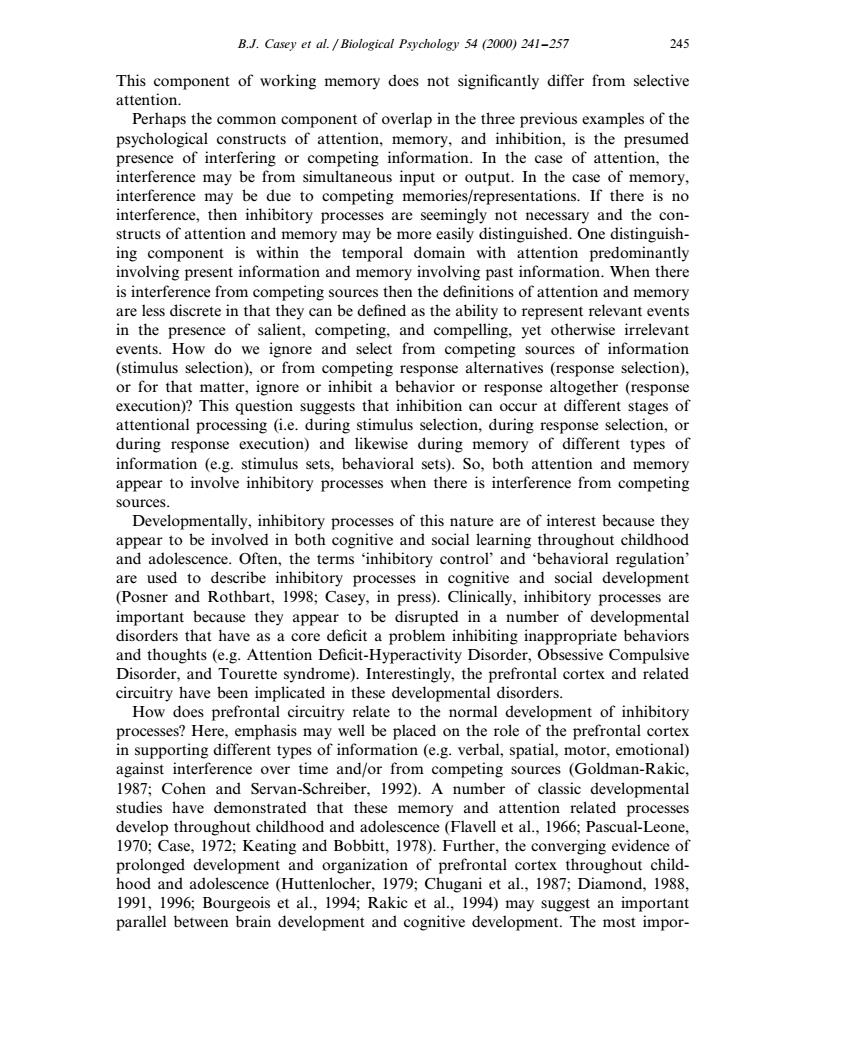正在加载图片...

B.J.Casey et al./Biological Psychology54(2000)241-257 245 This component of working memory does not significantly differ from selective attention Perhaps the common component of overlap in the three previous examples of the psychological constructs of attention,memory,and inhibition,is the presumed presence of interfering or competing information.In the case of attention,the interference may be from simultaneous input or output.In the case of memory, interference n ay be due en inhibit to compe emories/r esentations.If there is no interfe ory proc are see not nec and the structs of atter ion an ry may be i distingui ng componen within the temporal attention pre involving present information and memory involving past information.When there is interference from competing sources then the definitions of attention and memory are less discrete in that they can be defined as the ability to represent relevant events in the presence of salient,competing,and compelling,yet otherwise irrelevant events.How do we ignore and select from competing sources of information (stimulus selection)or fr natives sponse selection) or for that ter 01 respon (respon ution)?This que gnore or n suggests th ur at diferen attentional processing (i.e.during stimulus selection,during response selection,o during response execution)and likewise during memory of different types of information (e.g.stimulus sets,behavioral sets).So,both attention and memory appear to involve inhibitory processes when there is interference from competing sources inhibitory proc esses of this nature are of interest because they ear to be involved in both and social learni ng thre ughout childhood ten h e terms or y control'a and beh. regulation are used itory processes in co and (Posner and Rothbart,1998;Casey,in press).Clinically,inhibitory processes are important because they appear to be disrupted in a number of developmental disorders that have as a core deficit a problem inhibiting inappropriate behaviors and thoughts (e.g.Attention Deficit-Hyperactivity Disorder,Obsessive Compulsive Disorder.and Tourette syndrome).Interestingly,the prefrontal cortex and related circuitry have beet implicated in these develo mental disorders refron relate to the ormal devel opment of inhibitor processes?He emphasis may well be plac on t he prefrontal corte in supporting different types of information(e.g.verbal,spatial,moto emotional against interference over time and/or from competing sources (Goldman-Rakic 1987;Cohen and Servan-Schreiber,1992).A number of classic developmental studies have demonstrated that these memory and attention related processes develop throughout childhood and adolescence (Flavell et al.,1966:Pascual-Leone. 1970;Case,1972;Keating and Bobbitt,1978).Further,the converging evidence of ization prefr ex thr child. e(Hu ten et al. nd,198 1991, ugan 1996:Bourgeois et al 1994;Rakic et al.,1994)may suggest an importan parallel between brain development and cognitive development.The most impor-B.J. Casey et al. / Biological Psychology 54 (2000) 241–257 245 This component of working memory does not significantly differ from selective attention. Perhaps the common component of overlap in the three previous examples of the psychological constructs of attention, memory, and inhibition, is the presumed presence of interfering or competing information. In the case of attention, the interference may be from simultaneous input or output. In the case of memory, interference may be due to competing memories/representations. If there is no interference, then inhibitory processes are seemingly not necessary and the constructs of attention and memory may be more easily distinguished. One distinguishing component is within the temporal domain with attention predominantly involving present information and memory involving past information. When there is interference from competing sources then the definitions of attention and memory are less discrete in that they can be defined as the ability to represent relevant events in the presence of salient, competing, and compelling, yet otherwise irrelevant events. How do we ignore and select from competing sources of information (stimulus selection), or from competing response alternatives (response selection), or for that matter, ignore or inhibit a behavior or response altogether (response execution)? This question suggests that inhibition can occur at different stages of attentional processing (i.e. during stimulus selection, during response selection, or during response execution) and likewise during memory of different types of information (e.g. stimulus sets, behavioral sets). So, both attention and memory appear to involve inhibitory processes when there is interference from competing sources. Developmentally, inhibitory processes of this nature are of interest because they appear to be involved in both cognitive and social learning throughout childhood and adolescence. Often, the terms ‘inhibitory control’ and ‘behavioral regulation’ are used to describe inhibitory processes in cognitive and social development (Posner and Rothbart, 1998; Casey, in press). Clinically, inhibitory processes are important because they appear to be disrupted in a number of developmental disorders that have as a core deficit a problem inhibiting inappropriate behaviors and thoughts (e.g. Attention Deficit-Hyperactivity Disorder, Obsessive Compulsive Disorder, and Tourette syndrome). Interestingly, the prefrontal cortex and related circuitry have been implicated in these developmental disorders. How does prefrontal circuitry relate to the normal development of inhibitory processes? Here, emphasis may well be placed on the role of the prefrontal cortex in supporting different types of information (e.g. verbal, spatial, motor, emotional) against interference over time and/or from competing sources (Goldman-Rakic, 1987; Cohen and Servan-Schreiber, 1992). A number of classic developmental studies have demonstrated that these memory and attention related processes develop throughout childhood and adolescence (Flavell et al., 1966; Pascual-Leone, 1970; Case, 1972; Keating and Bobbitt, 1978). Further, the converging evidence of prolonged development and organization of prefrontal cortex throughout childhood and adolescence (Huttenlocher, 1979; Chugani et al., 1987; Diamond, 1988, 1991, 1996; Bourgeois et al., 1994; Rakic et al., 1994) may suggest an important parallel between brain development and cognitive development. The most impor-